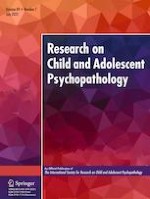23-02-2021
A Cross-Sectional and Longitudinal Test of the Low Sensitivity to Threat and Affiliative Reward (STAR) Model of Callous-Unemotional Traits Among Spanish Preschoolers
Gepubliceerd in: Research on Child and Adolescent Psychopathology | Uitgave 7/2021
Log in om toegang te krijgenAbstract
Despite advances in the theoretical and empirical literature, a better understanding of the etiological determinants of callous-unemotional (CU) traits is needed. In this study, we tested the hypotheses advanced by the Sensitivity to Threat and Affiliative Reward (STAR) model, a theoretical framework, which proposes that individual differences in two temperament dimensions, fearlessness and low affiliation, jointly contribute to the development of CU traits. Specifically, we examined the unique and interactive effects of fearlessness and low affiliation on CU traits, both cross-sectionally and longitudinally and within and across informants (teachers and parents) in a large community sample of Spanish preschoolers (N = 2467, 48.1% girls, M = 4.25 years; SD = 0.91). Both fearlessness and low affiliation were independently related to higher CU traits across models. Consistent with the purported relationships outlined in the STAR model, we also found that a significant interaction between fearlessness and low affiliation explained unique variance in CU traits. The results suggested that main and interactive effects were specific to CU traits and not to other related dimensions of psychopathic traits that are measurable in early childhood (i.e. grandiose-deceitfulness and impulse need of stimulation). Thus, we provide new empirical support to the hypotheses generated by the STAR model in relation to the development of CU traits. Fearlessness and low affiliation are potential targets of future child-focused interventions to prevent or treat the development of CU traits and childhood conduct problems.
